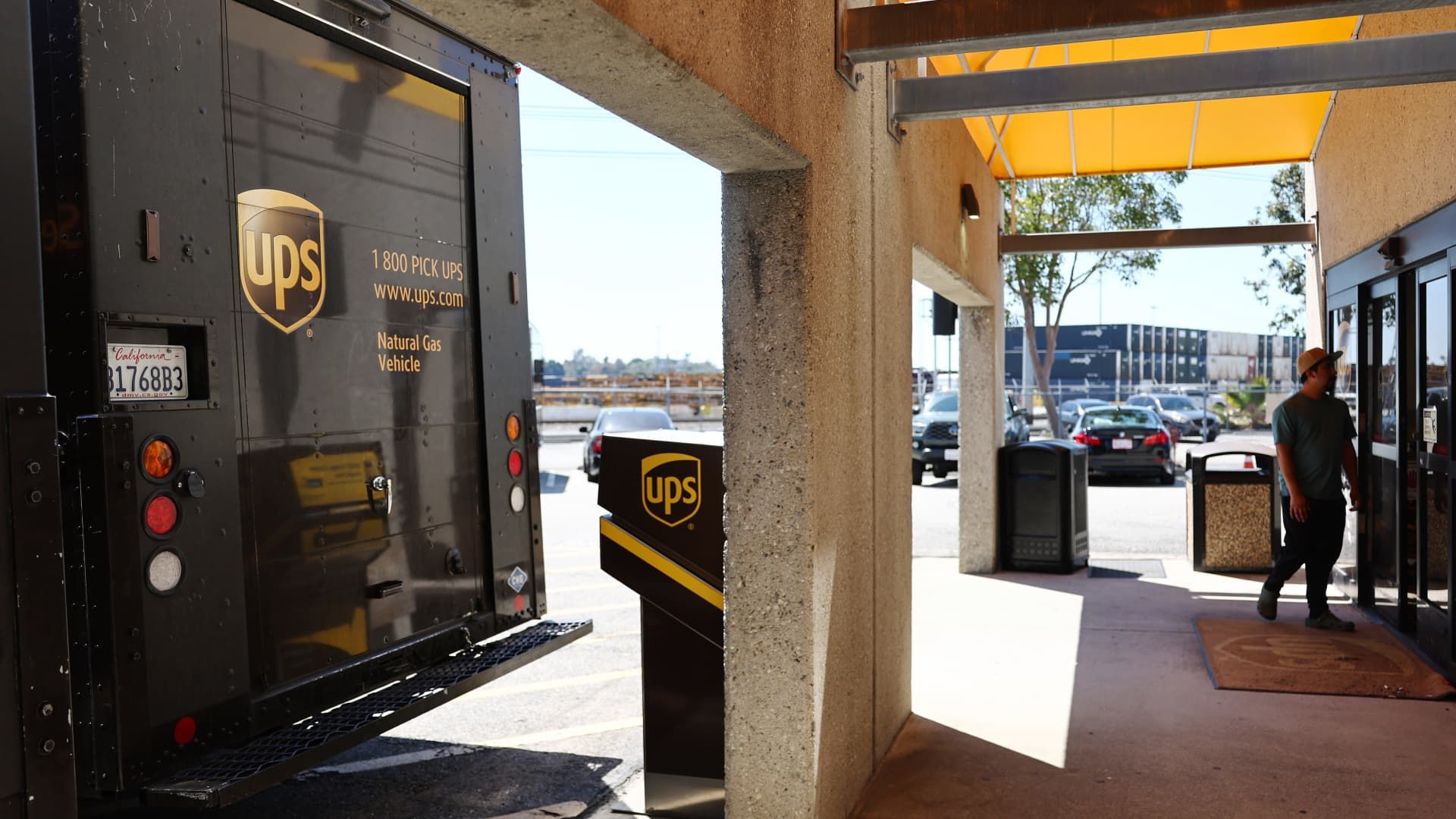A person enters a UPS (United Parcel Service) customer service center on April 1, 2024 in Los Angeles, California.
Mario Tama | Getty Images
United Parcel Service On Tuesday, it reported second-quarter earnings and revenue that fell short of expectations and cut its revenue guidance for 2024.
The company's shares fell more than 13% in midday trading, on track for their worst day on record.
“Our revenues were just below the low end given the volume momentum we are currently experiencing across our business,” UPS CEO Carol Tomé said during the company's earnings call. “As a result, we are adjusting our full-year operating margin guidance to reflect the nature of the volume flowing through our U.S. network.”
UPS expects 2024 revenue to be about $93 billion, revised from a previous guidance of up to $94.5 billion. However, full-year capital expenditures are expected to be about $4 billion, up from $4.5 billion.
UPS noted that the current outlook for 2024 still includes revenue from its Coyote Logistics transportation business, which the company recently announced it will sell to RXO, IncThe transaction is expected to close by the end of the year, freeing up cash that the company plans to use for share repurchases totaling about $500 million.
The company also recently signed an agreement to acquire Mexican express delivery company Estafeta, which the company plans to close by the end of the year.
Here's how the shipping giant fared in the quarter ended June 30 compared with what Wall Street expected, according to a survey of analysts by LSEG:
- Earnings per share: Adjusted 1.79 cents vs. $1.99 expected
- Revenue: $21.8 billion versus the expected $22.18 billion
The company's reported net income for the quarter was $1.41 billion, or 1.65 cents per share, compared with $2.08 billion, or $2.42 per share, a year earlier. Adjusted for the impact of the resolution of an “international regulatory matter,” UPS posted earnings of $1.79 per share.
The company reported operating profit of $1.94 billion, down from $2.78 billion a year earlier.
“This quarter was an important turning point for our business as we returned to volume growth in the United States for the first time in nine quarters,” Tomé said in the company's earnings release. “As expected, our operating profit decreased in the first half of 2024 compared to what we reported last year. Going forward, we expect to return to operating profit growth.”
Revenue also fell to $21.82 billion from $22.06 billion a year earlier, largely due to declines in the company's domestic and international segments.
Its US operation saw revenue decline by 1.9%, which the company said was mainly due to changes in product mix.
“Product mix is expected to continue to pressure revenue per piece; however, through expense management and slowing labor inflation, we expect to grow third quarter operating profit by double digits and exit the year with a U.S. operating margin of 10%,” said Chief Financial Officer Brian Dykes.
Aug. 1 will mark one year of UPS's massive five-year labor contract with the International Brotherhood of Teamsters, which included big wage increases. The company said during its earnings call that it expects cost pressures associated with the contract to “moderate dramatically in the second half” of the year.
UPS's international segment experienced a 1% decline in revenue during the second quarter, which UPS attributes to a 2.9% decline in average daily volume.
The company's third segment, supply chain solutions, increased revenue by 2.6% compared to the same period last year, mainly due to growth in logistics, including healthcare.
Shipping volumes
The report comes at a time when weak freight demand and low prices in the shipping industry are causing what some are calling a global freight recession. Investors had looked to UPS's results to see if demand was improving.
The company said it saw pockets of improvement in demand outside the US.
Volume growth in the quarter was driven in part by e-commerce, as business-to-consumer volume increased to represent 58.5% of UPS's total volume, the company said.
“Two new e-commerce customers have joined our network, and you can already guess who they are. These are new e-commerce carriers in the United States whose volume has been quite explosive,” said CEO Tomé.[The volume] “It certainly flowed into our network more than we expected.”
A recent note from a Wells Fargo analyst predicted that Temu and Shein were driving the market, responsible for “substantial global small package volume growth” and driving “favorable supply/demand and better pricing.”
Within the U.S., CFO Dykes said the company saw customers favoring “more economical products,” choosing Ground and its non-urgent SurePost value option over more expensive air shipping.
UPS recently landed an air cargo contract with rival U.S. Postal Service FedExwhich the company included in its fiscal 2024 guidance. UPS will become USPS's primary air cargo provider beginning Oct. 1, after the current FedEx contract expires.
Although financial details of the deal had not been previously disclosed, UPS referred to the award as “significant” in an April news release. The deal will bring FedEx $1.75 billion in fiscal year 2023, the company said.
Correction: UPS reported second-quarter earnings and revenue on Tuesday. An earlier version incorrectly stated the date.










